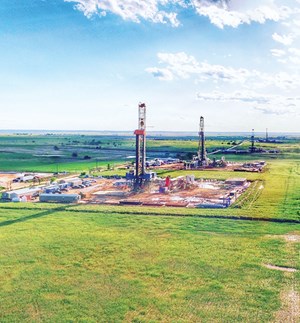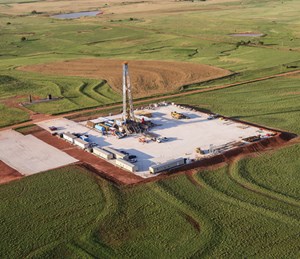Scoop/Stack shales
One of the few pure-play operators still active in one of Oklahoma’s uniquely acronymic shale plays has trouble understanding the bad rap being directed at what were once considered among the most fruitful rocks in the country.
“There has been an attack on the STACK, with some people actually questioning the quality of the play,” said Chaparral Energy, Inc. CEO Earl Reynolds, referring to the Sooner Trend Anadarko basin, Canadian and Kingfisher Counties’ multi-zone play in the Cana Woodford subset of the greater Anadarko basin.
“Just a few months ago, this basin was considered a top-tier basin, and I think everybody is fully aware of that. And, really, I don’t think anything that drove the basin to be considered top-tier has changed,” he said in a Nov. 12 call. “Great things that made it that basin are still there. I mean, all the way from source rock to deliverability of the wells.”
There is no denying, however, the significant pullback among the few operators largely controlling the STACK, the previously discovered SCOOP (South Central Oklahoma Oil Province), and the later arriving Merge, which lies between the two multi-zone plays.

Through December and early January, 23 rigs, on average, were active in the Cana Wooodford, compared to 58 rigs at the same time last year, according to Baker Hughes. Production also has been on a downward trajectory, with January oil and gas output expected to drop to 553,000 bpd and 7,523 MMcfd, respectively (Fig. 1), according to the U.S. Energy Information Administration (EIA). In January 2019, the EIA said the Anadarko region delivered 599,000 bopd and 7,644 MMcfgd.
Halliburton’s decision in December to shut down its El Reno, Okla., remote operations center underscores the precipitous retrenchment in the sister plays, once dubbed “Permian-lite,” in reference to the stacked pay horizons built around the Woodford shale, the primary source rock for Oklahoma production. Indeed, while helping drop completed well costs to below $6 million, in some cases, the Cana Woodford has not been kind to contractors and pressure pumping companies looking to heal their balance sheets.
“We’ve seen rig prices decrease in the 20% to 25% range. We’ve seen double-digit percentage decreases in our stimulation pricing. So, across really all the service product lines that we engage in, we’ve seen some preferential treatment there, and we’d anticipate that carrying on into 2020,” says Scott Donnelly, V.P. of Southern Region Production for premier leaseholder and SCOOP architect Continental Resources Inc.
BEATING EXPECTATIONS
Presently christened Encana Corp. certainly can’t be counted among the detractors. The 361,000-net-acre Anadarko basin leasehold was the driving force behind Encana’s all-stock $7.7-billion acquisition of STACK first-mover Newfield Exploration Co., which closed in February. “We are seven months in, and we have beaten everything we set out to do our first year,” CEO Doug Suttles told The Oklahoman on Sept. 19, following a presentation at the Petroleum Alliance of Oklahoma’s Wildcatters luncheon.

Shortly after taking control, the now-U.S. shale powerhouse introduced the cube development model to the Anadarko (Fig. 2), which is largely credited with dropping total well costs to an average of $6.5 million in 2019, compared to $7.9 million/well the year prior, with “pacesetter wells” coming in below $6 million.
Consequently, third-quarter production jumped to 162,000 boed, up 16% year-over-year, with activity focused primarily on the black oil window in the STACK Merrimack formation. Encana expected to wrap up 2019 with 75 to 85 net wells drilled, and 115 to 125 wells turned in line, at average lateral reaches of 10,000 ft.
Meanwhile, early this year, Encana hopes to have officially changed its corporate citizenship from Canada to the U.S. The move is designed to gain access to “deeper pools of investment capital,” said Executive V.P. and CFO Corey Code. Coinciding with the change in domicile, Encana will be re-branded under the esoteric name Ovintiv Inc.
Chaparral, for its part, closed out 2019 with a two-rig active fleet and the completion of 46 gross Meramec and Osage wells within the contiguous 129,000 acres comprising its STACK/Merge leasehold. With average lateral lengths of 4,901 ft, the 28 Meramec wells delivered three-phase, peak, 30-day IP rates averaging 943 boed gross, while the 18 lower Osage wells peaked out at a 30-day IP average of 621 boed from medium-lateral reaches of 4,937 ft.
Third-quarter production came in at 21,500 boed, with 13 gross wells put onstream, compared to 28 new producers in the prior quarter. With STACK/Merge production averaging more than 28,000 boed as of November, Chaparral expects to hit a 2019 average production target of 25,000 to 27,000 boed.
Chaparral commenced another Meramec development campaign in late November, with the start of drilling a six-well pad in Canadian County. Chaparral plans to run no more than two rigs this year as achieving both cash neutrality and growth take priority.
With its equity-funded merger with Gastar Exploration LLC set to close in the third quarter, privately held Chisholm Oil and Gas, LLC, of Tulsa, Okla., will emerge as a new force in the STACK exploration scene. The combination comprises around 165,000 net acres, primarily in Oklahoma’s Kingfisher County, with estimated production of 20,000 boed.
At the time the definitive agreement was announced on June 19, pure play Chisholm was running three rigs and a dedicated frac crew. No updated information has been made available as of Dec. 13.

Elsewhere, the times have been particularly hard on pure play operator Alta Mesa Resources Inc., which filed for temporary bankruptcy in September. Once among the most active STACK-centric operators, the company was averaging up to eight rigs a little over a year ago on a 139,000-net-acre position in the eastern Anadarko basin, Fig. 3.
Others holding positions mostly held by production (HBP) are pulling back and directing resources mainly to the oilier Permian basin.
DIALING BACK
With some 86% of its drilling and completion budget directed to the Permian’s Delaware basin, Cimarex Energy Co. wrapped up 2019 with no rigs or completion crews active across its 326,000-net-acre Woodford and Meramec shale holdings in western Oklahoma. The Anadarko basin makes up the company’s Mid-Continent region, where 52 gross (5 net) wells were turned-in-line during the third quarter, with 36 gross (2 net) wells drilled and awaiting completion at quarter’s end.
Cimarex says third-quarter completed costs for Meramec wells drilled with 10,560-ft laterals were down $1 million from the quarter prior, to a range of $8.5 million to $10 million. Nevertheless, the company is taking a temporary breather, as it further evaluates the Mid-Continent asset, with respect to new drilling and landing zones, aimed at fostering long-term sustainability. “We could easily put 30% or more of our capital in the Mid-Con next year and there would be opportunities that compete heads up,” CEO Tom Jorden said on Nov. 5.
Seeing better immediate returns in the Delaware, Oklahoma-based Devon Energy Corp., likewise, is shifting capital from Oklahoma to southeastern New Mexico. “Given recent weakness in gas and NGL (natural gas liquids) prices, we continue to reduce activity in the STACK. In fact, we’ve recently dropped to zero rigs in the play, as higher returns currently exist within other oilier projects in our portfolio,” Executive V.P. of Exploration and Production David Harris said on Nov. 6.
Just over a month later, Devon inked an agreement with Dow to jointly develop 133 undrilled STACK locations in exchange for an approximately $100-million drilling carry-over the next four years. Devon controls a contiguous 280,000-net-acre leasehold in the over-pressured STACK core, Under the agreement, drilling operations are expected to commence mid-year in northern Canadian County, Okla.
During the third quarter, Devon averaged two rigs and one frac spread and drilled four operated wells with average laterals of 9,600 ft, and put 16 wells on production. Third-quarter net production totaled 121,000 boed, with infill development projects, spaced at four to six wells/unit, bringing completed well costs to as low as $6 million/well.
President and CEO David Hager suggested the distribution of capital from its home base is a temporary response to the times. “It’s just because of the high quality of our portfolio that we are allocating more to the Delaware. But the STACK is still there. It’s not far away from getting funding, and it’s going to be a significant part of our portfolio for a long time to go, and you’re going to see capital allocated to STACK in future years,” he said.
EOG Resources Inc. averaged two rigs and a completion spread in 2019 and was scheduled to have completed around 30 wells at year-end. The company says Anadarko well costs have been reduced to $6.1 million/well, normalized to 9,500-ft laterals.
The Houston-based operator controls a comparably modest 35,000-net-acre position in the core of the eastern Anadarko Woodford oil window, which the company has labeled as the most recent premium drilling area. EOG has provided no details on current or near-term activity.
SPRINGBOARD BEATS FORECAST
Continental, for its part, completed 80 gross wells in the third quarter, lifting quarterly production to a record 133,266 boed and accounting for roughly half of the operator’s aggregate year-over-year oil growth. Of that, a higher-than-expected average of 23,641 bopd was attributed to the SCOOP Project SpringBoard, a current 47,000-gross-acre in-line development strategy, targeting the Springer and underlying Woodford and Sycamore shales. Since its initiation in early 2018, the flagship project in Grady County, Okla., has delivered some 8.7 MMbbl (gross) of oil, according to Continental, which holds a commanding SCOOP/STACK leasehold of more than 1.13 million net reservoir acres.
The 62%, year-over-year, increase in production comes as the operator reduces its Oklahoma rig count from 19 to 12 rigs and three frac crews. Nine of the active rigs were devoted to the expanding Project SpringBoard at year-end. “Efficiency gains out of SpringBoard have allowed us to release seven rigs in Oklahoma. We can do more with less capital expense,” CEO Harold Hamm told analysts on Oct. 31, in what presumably is his final conference call, after retiring at the start of the new year.
Continental has increased the earlier fourth-quarter SpringBoard production target by 2,000 bopd to 24,000 bopd. Most of the 39 recently drilled-but-uncompleted SpringBoard wells will be prepped to go online in early 2020.
Due north, 17 STACK wells were included in the total completions count, including 14 wells completed during the third quarter in two new units in the over-pressured oil window. As part of the wholesale shift of full-field STACK development that includes completions in both the upper and lower Meramec, the 14 wells, combined, delivered initial production (IP) rates of 38,320 bopd and 113.8 MMcfgd.
Marathon Oil Corp. approached the end of 2019 with a reduced four-rig fleet, concentrated solely in the “more oily and more economically competitive areas” within an approximately 300,000-net-acre STACK/SCOOP leasehold. Third-quarter production averaged 84,000 net boed (27% oil), with 19 gross operated wells put on production, largely from the over-pressured STACK, where the completed well costs for two recently constructed pads averaged $6.3 million/well, normalized to 10,000-ft laterals.
To increase the oil percentage, Marathon will focus near-term on the SCOOP, citing three Springer shale wells that recently went online at average 30-day IP rates of 1,460 boed, comprising 72% oil. Nine additional Springer wells were expected to hit the sales lines in the fourth quarter.

- Shale technology: Bayesian variable pressure decline-curve analysis for shale gas wells (March 2024)
- U.S. producing gas wells increase despite low prices (February 2024)
- U.S. drilling: More of the same expected (February 2024)
- U.S. oil and natural gas production hits record highs (February 2024)
- When electric meets intelligence: Powering a new era in hydraulic fracturing (January 2024)
- Next-generation electric fracturing system improves efficiency, ESG performance (January 2024)


